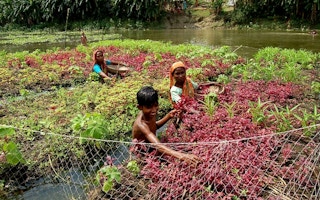Four traditional farming systems in Bangladesh and Japan have been designated today by FAO as “Globally Important Agricultural Heritage Systems.”
They include Bangladesh’s floating gardens, a unique hydroponics production system constructed with natural grasses and plants, which have been developed in flood areas; and a trio of sites in Japan: the sustainable river fisheries utilizing Sato-kawa system in Gifu, the Minabe-Tanabe Ume approach to growing apricots on nutrient-poor slopes in Wakayama; and the Takachihogo-Shiibayama mountainous agriculture and forestry system in Miyazaki which allows agricultural and forestry production in a steep mountainous area.
The sites were officially recognized during a joint meeting of the GIAHS Steering and Scientific Committee at FAO headquarters in Rome.
These new designations bring the number of Globally Important Agricultural Heritage Systems (GIAHS) systems to a total of 36 sites located in 15 countries in Africa, Latin America, Near East and Asia.
“In the context of today’s environmental and economic challenges and climate change, small-scale and family farmers, and especially traditional agriculture, can offer real solutions for food security, the conservation of natural resources and sustainable rural development, if adequate policies and investment are directed to them”, said FAO Deputy Director-General Maria Helena Semedo.
The Globally Important Agricultural Heritage Systems (GIAHS) which was launched by FAO in 2002 during the World Summit on Sustainable Development in Johannesburg, South Africa, has been recently endorsed by member countries, during the 39th Session of the FAO Conference, as an FAO Corporate Programme.
The new GIAHS sites include three in Japan and one in Bangladesh:
Japan - Ayu of the Nagara River System
The Nagara River is one of the cleanest rivers in Japan that provides a number of ecosystem services. Various components of the system such as river, forests and farmlands are closely linked to each other.
The sustainable inland fisheries of a specific type of fish (Ayu) benefit from clean waters of the Nagara River which are maintained through upstream forest management. Local communities have lived within this linked ecosystems and have developed their livelihoods and cultural practices.
Japan - Minabe-Tanabe Ume System
Minabe-Tanabe Ume System allows for the production of high-quality Ume (Japanese apricots) and various kinds of fruits on nutrient-poor slopes. Local communities have created a thriving Ume fruit production environment by maintaining upper coppice forests for landslide prevention and maintenance of water, and Japanese honeybee for pollinators.
By permitting the production of a diverse range of products, the system ensures stable livelihoods and makes communities more resilient to disasters.
Japan - Takachihogo-Shiibayama Mountainous Agriculture and Forestry System
This site is located in a steep mountainous area where flat land is extremely scarce. In this severe environment, local people have established a distinctive and sustainable system of agriculture and forestry which balances timber production with diverse farming activities — such as terraced rice growing, shiitake mushroom cultivation, beef cattle raising, or tea cultivation.The forest is maintained as a “mosaic” of conifers and broadleaf trees using traditional practices.
Bangladesh - Floating garden Agricultural Practices
Farmers in some parts of Bangladesh where flood waters can remain for a prolonged period of time have developed a unique hydroponics system in which plants can be grown on the water on floating organic bed of water hyacinth, algae and other plant residues.
This environmentally friendly traditional cultivation technique utilizes the natural resources of wetlands to grow vegetables and other crops almost all year round providing numerous social, economic, agricultural and ecological benefits to the local population.










